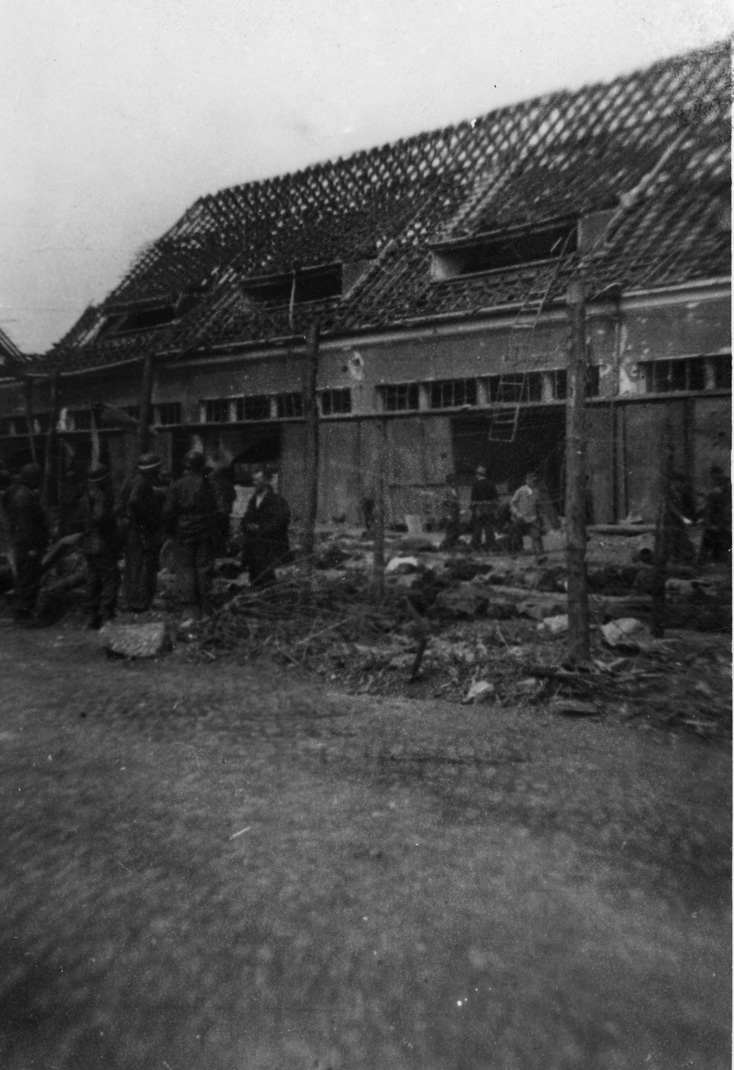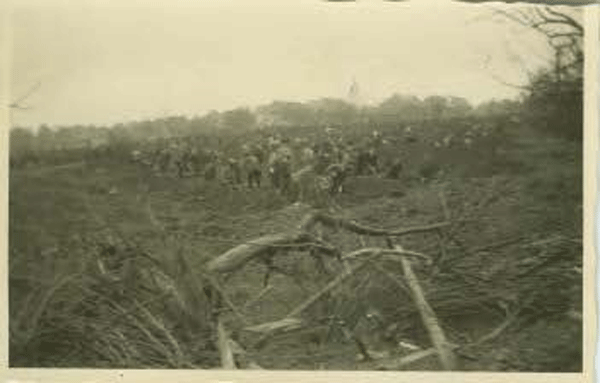This year marks the 70th Anniversary of the Allied Invasion of Normandy. Memorial services for the war’s causalities are taking place around the world. These services commemorate the dead and also attest to the scope and ferocity of the Second World War. Those who liberated concentration camps felt it was of utmost importance to ensure that this history was kept alive.
In the early morning of April 11th 1945, the Third Armored Division, specifically Task Force Welborn from the north and Task Force Loveday from the south, led the capture of what they thought was a prisoner-of-war camp.[1] After a few light skirmishes the nearby town of Nordhausen (in Northern-Central Germany) was secured. Once Nordhausen was seized 3AD units investigated rumors of a prisoner camp on the outskirts of the town. First person accounts note the bewilderment and nausea that the soldiers experienced upon finding the concentration camp. James D. Mathews recounted his own experiences:

“You must realize that the American troops had no inkling, not even a rumor, of the grisly discovery that they were about to make…We were totally unprepared for what assaulted our senses or for the abruptness of with which a new role was foisted on us. The half-crazed, emaciated victims trapped inside the camp barely resembled humans. Those who could walk, having heard the rumble of our tanks, had pressed themselves on the fence, crying, arms outstretched to their liberators. Some were too weak from starvation to even survive the emotion that enveloped prisoner and soldier alike.”[2]
Dora-Mittelbau was an atypical Nazi concentration camp as it functioned primarily as a manufacturing plant for the German V-1 and V-2 long range ballistics missiles. Dora, as it was later referred to by 3AD soldiers, was one of 88 “sub-camps” of Buchenwald, with direct administrative and political ties to the infamous larger camp. The Dora-Mittelbau facility was implemented in the summer of 1943 and by September held around 1,000 prisoners.[3] Dora consisted of both above-ground and underground components. The first prisoners who arrived from Buchenwald lived in a former barracks area outside of Nordhausen. They were put to work digging the two parallel two mile tunnels which would become Dora’s missile factory, as well as multiple levels of connecting tunnels. While prisoners residing in the Nordhausen barracks slept in three-tiered bunks with at least three people to a tier, there were no living quarters for the thousands of prisoners assigned to the construction of the subterranean tunnels. By late spring 1944, Dora began its forced missile production. By the summer of the same year wooden barracks were constructed and became the camp’s main hub, holding around 12,000 prisoners. Satellite sites within the boundaries of the camp held an additional 20,000 persons. The Nordhausen barracks became the destination for the unhealthiest prisoners and functioned as a place for them to die.[4]
By October 1944, Dora was almost entirely independent of Buchenwald and had 23 independent branches within its boundaries, places ranging from the distribution of “a daily diet of four ounces of black bread and a little bit of thin soup”[5] to the cremation of prisoners who died as a result of guard beatings, exhaustion, sickness, and starvation. Prisoners woke at 4 a.m. and those deemed healthy enough for missile production were marched into the tunnels. The underground facility was “tremendous, a labyrinth of tunnels from which coal-cars were trundled back and forth and up to the surface, where they were camouflaged (black and lumpy covers over the V-2s in the cars) and sent as coal-trains out to what were the launching locations.”[6]

Not all prisoners were complicit workers, even under the threats of severe beatings or death. A multinational group of prisoners formed in order to sabotage missile production and hamper the Nazi war effort. Within a few months of the camp’s underground factory becoming operational these saboteurs slowed the production process substantially. As a result, more than 200 prisoners were accused of sabotage and hanged.[7]
By November 1st 1944, Dora imprisoned 32,471 people. Compiled accounts of 3AD soldiers tell the story:
“…men like Peter Hahn, a German communist, who had been a constant inmate of the country’s concentration camps for eight years; like Pole Leitner, a Hungarian electrician, who was dying from the ravages of tuberculosis. They were fourteen year old boys and aged men. They were members of the French intelligence, Belgians, Poles, Russians- a very babel of tongues and nations, all dying together in the filth and dirt of their own dysentery.”[8]
For many prisoners, the capture of Dora by 3AD soldiers did not come soon enough to help them. In April 1945, the camp was evacuated and over 30,000 prisoners marched to Bergen-Belsen. Many died during the march from starvation, exhaustion, and disease. Others, primarily Jewish prisoners, were murdered in groups by machine-gun or burned alive. Prisoners left at the camp were still very much in danger as well. Prior to American seizure, Dora was bombed by Allied planes. Prisoners who sought cover were shot by guards.[9] Even after the capture of Dora-Mittelbau a prisoner’s survival was not guaranteed. This was hard to grasp for the 3AD soldiers who cared for the survivors of Dora, and unimaginable for liberated prisoners. Soldier James D. Mathews characterized this hard reality: “Our medical officers felt that there was little chance of half our patients surviving. The depth of their starvation was such that nothing would save them except the most delicate maneuvers. Many of them did not live through the day of their rescue despite our ministering.”[10]

The importance that many witnesses place on remembering these horrific events in human history must be emphasized. The words of a man who saw the atrocities first-hand convey this:
“There had been atrocities in Belgium, when SS troopers, realizing that the Americans were nipping at their heels, had murdered men, women, and children in their basements and in their churches. Even those discoveries were nothing compared to what we found at Nordhausen. And Nordhausen was but a microcosm of the same scene being re-enacted many, many times all over Europe.”[11]
For additional photographs of the camp click here.
(Warning: These images are graphic)
For original footage of Dora-Mittelbau click here.
(Warning: This footage is graphic)
[1] Correspondence between Hayne Dugan and Pierre C.T. Verhere, Dec. 16, 1995, Haynes Dugan Papers, 26/20/176, Student Life and Culture Archives.
[2] “Nordhausen; Lead and Lime”, p. 2, James D. Matthews, Third Armored Division Archives, Record Series 26/20/76, Student Life and Culture Archives.
[3] Correspondence between Hayne Dugan and Pierre C.T. Verhere, June, 1996, Haynes Dugan Papers, 26/20/176, Student Life and Culture Archives.
[4] “Spearhead in the West”, p. 148, Third Armored Division Archives, 26/20/76, Student Life and Culture Archives.
[5] “Nordhausen; Lead and Lime”, p. 3, James D. Matthews, Third Armored Division Archives, Record Series 26/20/76, Student Life and Culture Archives.
[6] Correspondence between Haynes Dugan and Maynard Britchford, Oct. 23, 1992, Haynes Dugan Papers, 26/20/176, Student Life and Culture Archives.
[7] United States Holocaust Memorial Museum, (http://www.ushmm.org/wlc/en/article.php?ModuleId=10005322).
[8] “Spearhead in the West”, p. 148, Third Armored Division Archives, 26/20/76, Student Life and Culture Archives.
[9] “Spearhead in the West”, p. 149, Third Armored Division Archives, 26/20/76, Student Life and Culture Archives.
[10] “Nordhausen; Lead and Lime”, p. 3, James D. Matthews, Third Armored Division Archives, Record Series 26/20/76, Student Life and Culture Archives.
[11] “Nordhausen; Lead and Lime”, p. 4, James D. Matthews, Third Armored Division Archives, Record Series 26/20/76, Student Life and Culture Archives.